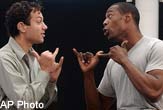Sign Language Improves Mental Abilities

Knowing Japanese may help you trade Yen on the Japanese stock market. Leading a safari tour in Kenya is much easier if you're well versed in Swahili.
And knowledge of American Sign Language comes in handy when studying structural geology.
Come again?
Structural geologists have to visualize the bending, breaking and folding of rock formations that are usually motionless and firm. This often requires the processing of complex spatial information—something that individuals experienced in American Sign Language, or ASL, already do well, explained Michele Cooke, a geologist at the University of Massachusetts Amherst.
Cooke's college students often struggle with structural geology, but when Cooke saw that those who are well versed in ASL grasp the spatial topics better, she thought there might be a connection.
"This is just my hypothesis and my studies are only anecdotal," Cooke said.
Let's find out
Sign up for the Live Science daily newsletter now
Get the world’s most fascinating discoveries delivered straight to your inbox.
To test her idea, Cooke and some colleagues are introducing students of six high schools for the deaf around the country to structural geology. About 80 students have been treated to a crash course of terminology and skills and each school built sandboxes to simulate fault systems in the classroom. After learning some of the basics, 20 of those students went to Utah to explore real faults for themselves.
The results were remarkable. During both experiments, the high school students made intuitive observations and were able to recognize geological concepts very quickly.
"I was amazed at how quickly these high school students picked up what my graduate students have problems picking up," Cooke told LiveScience.
The observations from Cooke's experiment were consistent with other findings by scientists who routinely work with those who use sign language.
Mental manipulation
"There is a wealth of evidence showing that native signers, deaf or hearing, are superior to non-signers in mental generation and mental manipulation, so a spatial-reasoning task would fit in nicely," said Marc Marschark, a researcher at Rochester Institute of Technology's National Technical Institute for the Deaf. Imagining the capital letter "N" and rotating it 90 degrees clockwise, can be done faster by deaf people than by hearing people. Hearing signers can also perform the task faster than hearing non-signers, Marschark said.
Wondering if the relationship between signing and spatial reasoning can be further validated, Cooke now tries to incorporate "ASL-based gestures" into the classroom by encouraging her students to communicate with their hands during discussions.
"So far our results have been inconclusive; the students are resistant to this kind of learning," Cooke said. "They need to get rid of their inhibitions and not feel intimidated by using their hands when they participate in class."
Marschark is not so sure whether there is enough scientific evidence that such training would improve spatial reasoning. "If someone is claiming that teaching ASL to non-native signers improves their spatial reasoning, that would be a bit more tenuous," he said. "Definitely worth investigation, but I would say that the jury is still out."
Why is yawning contagious?
Scientific consensus shows race is a human invention, not biological reality











